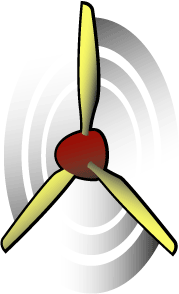 |
||||||||
| Issue Number 273 |
May
2002
|
|||||||
|
P.O. Box 189, Moffett Field, CA 94035-0189 |
||||||||
|
|
||||||||
 |
||||||||
| Issue Number 273 |
May
2002
|
|||||||
|
P.O. Box 189, Moffett Field, CA 94035-0189 |
||||||||
|
|
||||||||
![]()
All pilots are taught to be wary of wake turbulence, the "horizontal tornadoes" that trail behind the wingtips of any aircraft in flight, especially larger and heavier aircraft. The greatest hazard from wake turbulence is induced roll and yaw, particularly during the takeoff and landing phases where there is little altitude for recovery. A Captain's recent report to ASRS offers a graphic example of wake turbulence hazard:
My PA31-350 aircraft entered an uncommanded right bank of 60 degrees... I confirmed that both engines were making full power. I applied opposite aileron input to counteract the uncommanded bank. I was unable to escape the effects of the wing tip vortices. I exited the vortex approximately 800 horizontal feet later... The airplane wings leveled, and then the aircraft entered a second uncommanded bank of 20-30 degrees, this time to the left. At approximately 1/4 the way down the runway, I regained complete control...
The Tower controller...requested that I join left downwind, cleared to land. I followed the request and landed safely.
Upon taxiing clear of the active runway, the Tower/Ground controller asked, "Is everyone OK?" Upon reaching the parking area...I discovered that there were no injuries.
When the Tower gave me clearance to land, I looked to see where the 727 was on the approach. At the time I felt I was far enough behind the 727 to limit my exposure to his wake turbulence. Obviously, this was incorrect...
The Aeronautical Information Manual (Chapter 7, Section 3) and Order 7110.65N, Air Traffic Control (Paragraphs 2-1-19 and 2-1-20) explain the respective pilot and controller responsibilities for wake turbulence avoidance. ATC is responsible in both VFR and IFR conditions for issuing wake turbulence advisories. An airport's air traffic controllers will provide an advisory to any VFR aircraft on its frequency that may, in the controller's opinion, be adversely affected by wake turbulence from a larger aircraft. This advisory will give the position, altitude (if known) and direction of flight of the larger aircraft, followed by the phrase, "Caution - Wake Turbulence."
However, if a pilot accepts a visual approach clearance to follow an aircraft, the pilot accepts responsibility for separation and wake turbulence avoidance. Because wake turbulence is unpredictable, the controller is not responsible for predicting its existence or effect.
When any doubt exists about maintaining safe separation distances between aircraft during approaches, pilots should ask the Tower controller for updates on separation distance and aircraft ground speed.
Respect Rotary Wing Wake

Helicopter wakes may be of significantly greater strength than those from a fixed wing aircraft of the same weight. The strongest wake can occur when the helicopter is operating at lower speeds (20-50 knots), as discovered by this General Aviation fixed wing pilot:
This event was classified as an incident rather than an accident. Rotor vortices circulate outward, upward, around, and away from the main rotor(s) in all directions. Pilots of small aircraft should operate three or more rotor diameters away from any helicopter in a slow hover taxi, or stationary hover.
 A
Cessna pilot influenced by "get-home-itis" ignored obvious
signs during a run-up and takeoff that all was not right with the prop
control.
A
Cessna pilot influenced by "get-home-itis" ignored obvious
signs during a run-up and takeoff that all was not right with the prop
control.
Procedures not recommended: Use of force on a cockpit control, and ignoring a low RPM setting during takeoff.


A General Aviation pilot landed at an airport in the early evening to refuel his airplane on a cross-country flight. All proceeded normally until it was time to restart the engine.
I was informed that although my airplane was substantially damaged, this incident did not meet the definition of an "aircraft accident" as defined in NTSB 830...
Most hand-propping accidents occur either because an airplane is left unattended, or because an unqualified person is at the controls. Pilots who undertake this procedure should always assume that the propeller is "hot" (will start of its own volition) and have a qualified, fully briefed person at the controls. The FAA also recommends that prior to start-up, the aircraft rotating beacon or strobe should be turned on to alert persons nearby that the propeller will be set in motion.
An air carrier Captain recently filed this report with ASRS describing "electronic sensory saturation during a critical phase of flight."
As the descent continued, the flight warning computer added the aural warning, "Too low gear." About this time we were given a heading to intercept the ILS final while still descending to 3,000 feet... It was at this time the TCAS added, "Traffic, Traffic!" As I was looking for the traffic I had to compete with a continuous level III alert chime, "Too low gear" aural alert and now the aural TCAS traffic alert. Again, none of these warnings can be silenced...
I looked for the traffic... Sure enough, there was a single-engine high wing aircraft in a left climbing turn. I called out "traffic in sight" about the same time the TCAS started calling, "Climb, Climb!" The pilot flying followed the TCAS guidance and we narrowly missed this aircraft. Somewhere in this sequence the landing gear alert ended... I changed to Tower and the rest of the approach and landing was normal.
As I replay these events, a couple of things bother me... I communicated to the pilot flying that I had the aircraft in sight. He could have interpreted this to mean there's no immediate conflict... Had he not followed the TCAS guidance, I think we would have hit the other aircraft.
If I had to do it over again, I would do the following:
| ASRS Recently Issued Alerts On... |
|---|
| CL65 Uncommanded yaw and roll at FL310 |
| Dassault Falcon 20 brake handle malfunction |
| EMB 145 main and auxiliary trim actuator failure |
| Taxiway "hold short" markings at several airports |
| Runway conflict between a departing G-IV and taxiing B727 |
|
March
2002 Report Intake
|
|
|---|---|
| Air Carrier/Air Taxi Pilots |
2,155
|
| General Aviation Pilots |
735
|
| Controllers |
69
|
| Cabin/Mechanics/Military/Other |
171
|
| TOTAL |
3,130
|